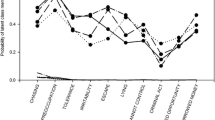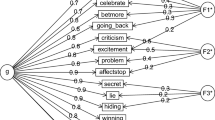Abstract
A common assumption in many public frameworks is that the harms and behavioural risk factors associated with gambling disorder lie on a continuum. At one end is lower risk or recreational gambling, and at the other, problem or disordered gambling. Movements along this continuum are associated with gradual increases or decreases in the level of behaviour and associated harm. This perspective is often advanced in opposition to more clinical or categorical frameworks that view problem gambling as a distinct clinical category from the other groups. In this paper, we investigate these competing perspectives with reference to 15 years of Australian prevalence studies. We examine the relationship between PGSI severity classifications and the endorsement of the principal criteria of the DSM-5 (e.g. tolerance, chasing, impaired control). The results showed that while elements of behavioural dependence increase across the PGSI categories (low to moderate to problem), problem gamblers have disproportionately greater endorsement. The PGSI severity and behavioural dependence relationship corresponds more strongly to a J-curve than a linear or r-curve and therefore lends greater support of a more categorical conceptualisation of the disorder.


Similar content being viewed by others
Notes
Data from 6 surveys were available to the authors to calculate an estimated mean value.
References
Abbott, M., Williams, M., & Volberg, R. (1999). Seven years on: A follow-up study of frequent and problem gamblers living in the community. Report No. 2 of the New Zealand Gambling Survey. Wellington: Department of Internal Affairs.
AC Nielsen. (2006). Prevalence of gambling and problem gambling in NSW: A community survey 2006. Sydney: NSW Office of Liquor, Gaming and Racing.
ACIL Allen Consulting. (2011). Second social and economic impact study of gambling in Tasmania. Hobart: Tasmanian Government Department of Treasury and Finance.
ACIL Allen Consulting. (2013). Third social and economic impact study of gambling in Tasmania. Hobart: Tasmanian Government Department of Treasury and Finance.
ACIL Allen Consulting (2017). Fourth social and economic impact study of gambling in Tasmania. Hobart: Tasmanian Government Department of Treasury and Finance.
Blaszczynski, A., & Nower, L. (2002). A pathways model of problem and pathological gambling. Addiction, 97, 485–497.
Browne, M., & Rockloff, M. J. (2019). Measuring behavioural dependence in gambling: A case for removing harmful consequences from the assessment of problem gambling pathology. Journal of Gambling Studies. https://doi.org/10.1007/s10899-019-09916-2.
Browne, M., Langham, E., Rawat, V., Greer, N., Li, E., Rose, J., Rockloff, M., Donaldson, P., Thorne, H., Goodwin, B., Bryden, G., & Best, T. (2016). Assessing gambling-related harm in Victoria: A public health perspective. Melbourne: Victorian Responsible Gambling Foundation.
Browne, M., Rockloff, M., Hing, N., Russell, A., Murray-Boyle, C., & Rawat, V. (2019). NSW gambling survey, 2019. Sydney: NSW Responsible Gambling Fund.
Cowlishaw, S., Merkouris, S., Dowling, N., Rodda, S., Suomi, A., & Thomas, S. L. (2018). Locating gambling problems across a continuum of severity: Rasch analysis of the Quinte Longitudinal Study (QLS). Addictive Behaviors, 92, 32–37.
Currie, S. R., Hodgins, D., Wang, J., & el-Guebaly, N., Wynne, H., & Chen, S. (2006). Risk of harm among gamblers in the general population as a function of level of participation in gambling activities. Addiction, 101, 570–580.
Davidson, T., Rodgers, B., Taylor-Rogers, E., Suomi, A., & Lucas, N. (2015). 2014 survey on gambling, health and wellbeing in the ACT. Canberra: Centre for Gambling Research.
Delfabbro, P. H., & King, D. (2017). Prevention paradox logic and problem gambling: Does low risk gambling impose a greater burden of harm than high risk gambling? Journal of Behavioral Addictions, 6, 163–167.
Delfabbro, P. H., & King, D. (2019). Challenges in the conceptualisation and measurement of gambling-related harm. Journal of Gambling Studies, 35, 743–755.
Department of Communities and Social Inclusion. (2012). Gambling prevalence in South Australia. Adelaide: DCSI.
Ferris, J. & Wynne, H., (2001). The Canadian problem gambling index final report. Phase II final report to the Canadian Interprovincial Task Force on Problem Gambling.
Griffiths, M. D. (2005). A ‘components’ model of addiction within a biopsychosocial framework. Journal of Substance Use, 10, 191–197.
Holdsworth, L., Haw, J., & Hing, N. (2011). The temporal sequencing of problem gambling and comorbid disorders. International Journal of Mental Health and Addiction, 10, 197–209.
International Classification of Disorders (ICD) (2019). ICD-11 for mortality and morbidity statistics. https://icd.who.int/browse11/l-m/en#/http://id.who.int/icd/entity/1041487064.
Jackson, A. C., Wynne, H., Dowling, N. A., Tomnay, J. E., & Thomas, S. A. (2010). Using the CPGI to determine problem gambling prevalence in Australia: Measurement issues. International Journal of Mental Health and Addiction, 8, 570–582.
Kessler, R. C., Hwang, I., LaBrie, R., Petukhova, M., Sampson, N. A., Winters, K. C., & Shaffer, H. J. (2008). DSM-IV pathological gambling in the National Co-morbidity Survey Replication. Psychological Medicine, 38, 1351–1360.
Korn, D., & Shaffer, H. (1999). Gambling and the health of the public: Adopting a public health perspective. Journal of Gambling Studies, 15, 289–365.
Lesieur, H., & Blume, S. (1987). The South Oaks Gambling Screen (the SOGS): A new instrument for the identification of problem gamblers. American Journal of Psychiatry, 144, 1184–1188.
Livingstone, C., Rintoul, A., de Lacy-Vawdon, C., Borland, R., Dietze, P., Jenkinson, R., Livingston, M., Room, R., Smith, B., Stoove, M., Winter, R., & Hill, P. (2017). Identifying effective policy interventions to prevent gambling-related harm. Melbourne: Victorian Responsible Gambling Foundation.
Lorrains, F. K., Cowlishaw, S., & Thomas, S. A. (2011). Prevalence of comorbid disorders in problem and pathological gambling: Systematic review and meta-analysis of population surveys. Addiction, 106, 490–498.
Markham, F., Young, M., & Doran, B. (2016). The relationship between player losses and gambling-related harm: Evidence from nationally representative cross-sectional surveys in four countries. Addiction, 111, 320–330.
McCormick, J., Delfabbro, P., & Denson, L. (2012). Psychological vulnerability and problem gambling: An application of Durand Jacobs' general theory of addictions to electronic gaming machine playing in Australia. Journal of Gambling Studies, 28, 665–690.
Moran, E. (1970). Varieties of pathological gambling. British Journal of Psychiatry, 116, 593–597.
Neal, P., Delfabbro, P. H., & O’Neil, M. (2005). Problem gambling: Towards a national definition. Melbourne: Gambling Research Australia.
Public Health Agency of Sweden. (2016). Gambling and gambling problems in Sweden 2008–2010. Stockholm: Public Health Agency of Sweden.
Queensland Government (2007). Queensland household gambling survey 2006–07. Brisbane.
Queensland Government (2009). Queensland household gambling survey 2008–09. Brisbane.
Queensland Government (2012). Queensland household gambling survey 2011–12. Brisbane.
Queensland Government (2018). Queensland household gambling survey 2016–17. Brisbane.
Rockloff, M., Browne, M., Hing, N., Thorne, H., Russell, A., Greer, N., Tran, K., Brook, K., & Sproston, K. (2019). Victorian population gambling and health survey (2018–19). Melbourne: Victorian Government.
Schottler Consulting. (2015). Study of gambling and health in Victoria. In Findings from the Victorian prevalence study 2014. Melbourne: VRGF.
Shaffer, H. J., & Korn, D. A. (2002). Gambling and related mental disorders: A public health analysis. Annual Review of Public Health, 23, 171–212.
Shah, K. R., Eisen, S. A., Xian, H., & Potenza, M. (2005). Genetic studies of pathological gamblers: A review of methodology and analyses of data from the Vietnam era twin registry. Journal of Gambling Studies, 21, 179–203.
South Australia Centre for Economic Studies. (2008). Social and economic cost of gambling in Tasmania. Vol 2. Prevalence study. Hobart: Department of Treasury and Finance.
South Australian Department for Families and Communities. (2005). Gambling prevalence in South Australia. Adelaide: DFC.
Sproston, K., Hing, N., & Palankay, C. (2012). Prevalence of gambling and problem gambling in New South Wales. Sydney: NSW Office of Liquor, Gaming and Racing.
Strong, D. R., & Kahler, C. W. (2007). Evaluation of the continuum of gambling problems using the DSM-IV. Addiction, 102, 713–721.
Victorian Responsible Gambling Foundation. (2014). The Victorian gambling study: A longitudinal study of gambling and health in Victoria 2008–2012. Melbourne: VRGF.
Williams, R. J., Hann, R. G., Schopflocher, D., West, B., McLaughlin, P., White, N., King, K., & Flexhaug, T. (2015). Quinte longitudinal study of gambling and problem gambling. Guelph, Ontartio: Ontario Problem Gambling Research Centre.
Woods, K., Sproston, K., Brook, K., Delfabbro, P., & O’Neil, M. (2018). Gambling prevalence in South Australia. Adelaide: Department of Human Services.
Author information
Authors and Affiliations
Corresponding author
Ethics declarations
This paper is a review of results in pre-existing reports and is exempt for separate ethical review under the NHRMC National Statement in Australia.
Conflict of Interest
The authors declare no competing interests.
Disclosure of Interests
Paul Delfabbro
I have received funding for research, support for conference travel and speaking engagements from government and non-government research bodies such as AGRI, VRGF, IAGR, and the Department of Consumer Affairs, GambleAware/RGT, Gambling Research Australia, Independent Gambling Authority, the ARC, NHMRC, Channel 7 Children’s Foundation, and Australian Institute of Criminology. I have conducted paid consultancy work on responsible gambling for regulatory bodies, government, and peak bodies such as the Australasian Gambling Commission and reviews of responsible gambling programs for some industry groups (e.g. reviews of list of indicators, self-exclusion program, host responsibility quality in relation to international best practice), but not received direct industry funding for any research. I acknowledge that many peak research bodies are indirectly funded by industry through levies or contributions.
Daniel King
I have received funding for research, support for conference travel and speaking engagements from government and non-government research bodies such as the VRGF, SSBA, and the ARC. I have conducted paid consultancy work on gaming disorder and gaming-gambling convergence, but not received direct industry funding for any research. I am a member of a World Health Organization advisory group on gaming disorder.
Additional information
Publisher’s Note
Springer Nature remains neutral with regard to jurisdictional claims in published maps and institutional affiliations.
Rights and permissions
About this article
Cite this article
Delfabbro, P., King, D.L. Is There a Continuum of Behavioural Dependence in Problem Gambling? Evidence from 15 Years of Australian Prevalence Research. Int J Ment Health Addiction 20, 2208–2220 (2022). https://doi.org/10.1007/s11469-021-00509-y
Accepted:
Published:
Issue Date:
DOI: https://doi.org/10.1007/s11469-021-00509-y




